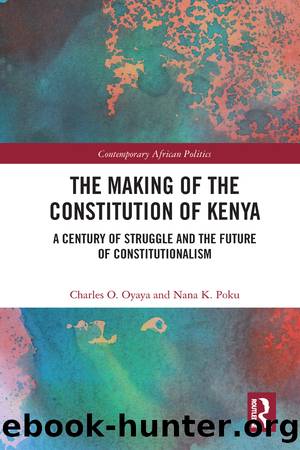The Making of the Constitution of Kenya: A Century of Struggle and the Future of Constitutionalism by Charles O Oyaya & Nana K Poku

Author:Charles O Oyaya & Nana K Poku [Oyaya, Charles O & Poku, Nana K]
Language: eng
Format: epub
Tags: Ethnic Studies, African Studies, Social Science, Political Science, General
ISBN: 9781317161738
Google: fX1aDwAAQBAJ
Goodreads: 40142418
Publisher: Routledge
Published: 2018-05-11T00:00:00+00:00
The second session of the National Constitutional Conference
The second session of the National Constitutional Conference (Bomas II) promptly started on Tuesday, 18th August 2003. It began in an atmosphere of increased tension within the ruling coalition. It is noteworthy that earlier in August 2003 just before the start of the second session, President Kibakiâs National Alliance of Kenya (NAK) had engineered the removal of his coalition partner and Leader of Liberal Democratic Party (LDP), Hon. Raila Odinga, as the chairman of the Parliamentary Select Committee on the Constitution Review. Biketi Kikechi explains the circumstances thus:
Cracks within the Narc Coalition Government deepened towards the end of 2003, creating more pitfalls for the constitution review. The tensions between the National Alliance of Kenya and Liberal Democratic Party (LDP) over the constitutional reform process culminated into the removal of Liberal Democratic Party Leader, Raila Odinga, from the Chairmanship of the Parliamentary Select Committee on the Constitution. Raila had served the PSC since 1999, and was instrumental in the constitution of the Constitution of Kenya Review Commission chaired by Prof Yash Pal Ghai. Justice Minister Kiraitu Murungi mobilised MPs to vote against him, and replaced him with another pro-reform MP and Safina party leader Hon. Paul Muite.28
The National Constitutional Conference was therefore to become the main arena of political contest with each faction of the ruling coalition seeking to control both the process and its outcome.
The main task of the second session of the conference was to discuss and consider the Commission Report and Draft Bill through 13 Technical Working Committees (TWCs) after the general debate during the first session of the conference. The TWCs were TWC âAâ â Preamble, Supremacy of the Constitution, the Republic and National Goals, Values and Principles; TWC âBâ â Citizenship and the Bill of Rights; TWC âCâ â Representation of the People; TWC âDâ â The Executive; TWC âEâ â The Judiciary; TWC âFâ â The Legislature; TWC âGâ â Devolution; TWC âHâ â Public Finance, Public Service, Leadership and Integrity; TWC âIâ â Defence and National Security; TWC âJâ â Land Rights and the Environment; TWC âKâ â Constitutional Commissions and Amendments to the Constitution; TWC âLâ â Transitional and Consequential Arrangements; and TWC âMâ â Culture. The Technical Working Committees had four key functions:
(a)âto examine all issues raised during the general debate and any other issues touching on matters provided for in the Report and Draft Bill;
(b)âto propose amendments or changes to the contents of the Report and/or Draft Bill in relation to matters under their specific thematic mandate;
(c)âto report on their proposed amendments to the Steering Committee or the Conference; and
(d)âto consider and report on any other matter referred to it by the Steering Committee or the Conference.
Download
This site does not store any files on its server. We only index and link to content provided by other sites. Please contact the content providers to delete copyright contents if any and email us, we'll remove relevant links or contents immediately.
The Secret History by Donna Tartt(18130)
The Social Justice Warrior Handbook by Lisa De Pasquale(11949)
Thirteen Reasons Why by Jay Asher(8436)
This Is How You Lose Her by Junot Diaz(6426)
Weapons of Math Destruction by Cathy O'Neil(5817)
Zero to One by Peter Thiel(5480)
Beartown by Fredrik Backman(5340)
The Myth of the Strong Leader by Archie Brown(5231)
The Fire Next Time by James Baldwin(5011)
How Democracies Die by Steven Levitsky & Daniel Ziblatt(4950)
Promise Me, Dad by Joe Biden(4906)
Stone's Rules by Roger Stone(4846)
100 Deadly Skills by Clint Emerson(4683)
A Higher Loyalty: Truth, Lies, and Leadership by James Comey(4544)
Rise and Kill First by Ronen Bergman(4542)
Secrecy World by Jake Bernstein(4382)
The David Icke Guide to the Global Conspiracy (and how to end it) by David Icke(4374)
The Farm by Tom Rob Smith(4320)
The Doomsday Machine by Daniel Ellsberg(4240)
